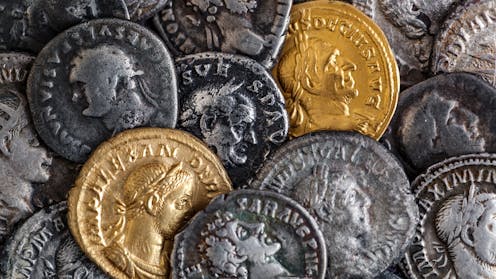History is full of failed attempts to establish new currencies. So what makes crypto different?
- Written by Hiroki Shin, Associate Professor of History, University of Birmingham

The confusion and commotion over cryptocurrency often reminds me of the 19th-century German drama Faust[1]. In Goethe’s masterpiece, the devil Mephistopheles offers an emperor the tantalising vision of limitless wealth through the printing of paper money.
The emperor grasps the idea (unheard of at the time the play is set), and the magical wealth which paper creates brings brief prosperity to his troubled dominion.
But what appeared to be an inexhaustible source of value soon proves illusory. A combination of misunderstanding and hype leads to economic and moral corruption, and the empire descends into chaos.
It is a tale which could well have parallels for digital currencies now. People use them despite not fully understanding how they work, sometimes to their financial loss[2].
And history shows us that we should be wary of the idea that currency systems always change for the better, following some sort of natural evolutionary path. In fact, new currency systems don’t always succeed, and even when they do, monetary regime change can be a long and arduous process.
Coins and tokens were used more than 2,000 years ago, and continued through to the 19th century before paper finally dominated. Rather than a clean, irreversible shift from coins to notes, nations often alternated between the two systems.
There were failed experiments with paper money in 14th-century China[3], 17th-century Sweden[4] and 18th-century France[5], to mention just a few.
Research on these problematic attempts suggests that social division also makes new currency shifts especially vulnerable[6].
During the American war of independence for example, a currency (the “continental dollar”) was briefly introduced in 1775. It was later abandoned due to mismanagement and misunderstanding[7], but had also served to sharpen political tensions between the patriots who supported it, and the loyalists to Britain, who detested it.
Similarly, in the 1750s and 1760s, the Swedish government issued non-redeemable paper money to pay its war debts. The consequent extreme inflation coincided with intense social division[8] and led to a period of political chaos.
In 1789, at the start of the French Revolution, a paper form of government bond was issued, which rapidly lost its value. Seven years later, the “assignat” had become virtually worthless[9].
Britain fared slightly better, as I explore in my book The Age of Paper[10]. Its departure from the metal standard in 1797, amid the financial pressures of the Anglo–French war[11], did not produce a collapse of the nation’s paper currency.
But the paper-based regime came to a halt in 1819, a year of bitter class conflicts, which culminated in the Peterloo massacre[12], where at least 18 people were killed and hundreds wounded by the cavalry at a peaceful rally for democratic reform. The public had come to detest Bank of England notes, which became a symbol[13] of economic depression and political oppression.
Britain then followed the pattern of other nations, reverting to a traditional monetary system that rested on the solid value of precious metals.
These cases of failed paper currencies – and there are many more – show that the general acceptance of currency ultimately requires shared values and social solidarity. Paper currency works when people trust it, knowing that it has been valued and accepted by others in the past, and will be valued and accepted in the future.
It would otherwise be unlikely for a piece of paper to become a reliable means of payment and value. Once such shared values are lost, there is usually a downward cycle of currency depreciation.
In the 21st-century, cryptocurrencies challenge the conventional idea of money as something of value – or at least linked to something of value, like gold. And as something that is issued and managed by a trusted central authority.
For cryptocurrencies exist only in the realm of blockchain technology. Their value is created and maintained not by central banks, but by complex computer algorithms.
To many[15], all of these abstract computational processes make cryptocurrencies as mysterious as Mephistopheles’ dark magic in Faust.
Even so, with Donald Trump’s strong support, cryptocurrencies are enjoying a surge in popularity[16]. This trend will undoubtedly be reinforced by further deregulation[17] which means requirements for transparency will be relaxed, and safeguards for consumer protection weakened.
The rise in popularity has coincided with the US government’s apparent preference[18] for weakening the dollar in the international currency markets as a way of boosting US exports by pushing down the prices of US goods abroad.
These events may lead to a profound transformation in the monetary system on a global scale. As the US dollar loses value and crypto regulations are relaxed, countries and investors around the world may be enticed to diversify their assets and increase their holdings of cryptocurrency.
But the combination of social division and rapid expansion may not be a positive sign for the future of cryptocurrency. Far from establishing it as a dominant medium of exchange in a new decentralised regime, history suggests that its rapid growth in a fractured society might instead accelerate its self-destruction.
References
- ^ Faust (www.britannica.com)
- ^ financial loss (www.sciencedirect.com)
- ^ 14th-century China (www.hoover.org)
- ^ 17th-century Sweden (www.bavarikon.de)
- ^ 18th-century France (www.researchgate.net)
- ^ especially vulnerable (papers.ssrn.com)
- ^ mismanagement and misunderstanding (press.uchicago.edu)
- ^ intense social division (onlinelibrary.wiley.com)
- ^ become virtually worthless (www.sciencedirect.com)
- ^ The Age of Paper (www.cambridge.org)
- ^ Anglo–French war (link.springer.com)
- ^ Peterloo massacre (theconversation.com)
- ^ became a symbol (oll.libertyfund.org)
- ^ revers/Shutterstock (www.shutterstock.com)
- ^ To many (cryptoliteracy.org)
- ^ enjoying a surge in popularity (www.npr.org)
- ^ further deregulation (www.whitehouse.gov)
- ^ apparent preference (www.theguardian.com)







